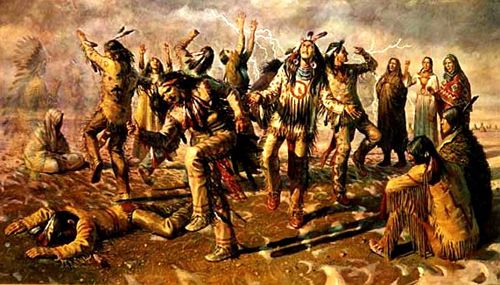Story of Native Americans And The Battle of Little Bighorn

The destruction of a cultural
The American Indians, more correctly called "Native Americans", made history when Christopher Columbus discovered in 1492 the continent he mistakenly called the Indies. These populations, which at the time counted approximately twenty-two million individuals, descended from various ethnicities of Mongolian race which had reached Alaska by crossing Siberia and the Bering Strait. They gradually spread over the continent, descending to Tierra del Fuego.
For the indigenous populations, the meeting with the Whites was a kind of "leap into the unknown". They first had to confront the missionaries whom, along with Christopher Columbus on his second trip, tried to convert them "peacefully".
Then it was the turn of the conquistadors who, in 40 years of exploration and oppression, destroyed the fragile balance of Central and South America. The breakdown of this balance had the effect of corrupting indigenous cultures, unleashing bloody wars, from which the Indians came out severely affected.
In 1830, the United States decided to return certain territories to the Native Americans who had been removed from their region of origin. However, these new spaces were gradually reduced under the influence of pressure from the white colonizers.
Today, there are 2,500 reservations in the United States and Canada, and 381 of the 600 "native" nations have been recognized, where about 150 different languages are spoken.
The ghosts of the river
On June 25, 1876, the blue tunics commanded by General George Armstrong Custer suffered a terrible defeat near the river of Little Bighorn. By its magnitude and its impact, this bloody event became legend and is nowadays known as The Battle of the Little Bighorn. Even today, not only historians, but also a large number of enthusiasts are wondering about this terrible massacre, and people of all nationalities and cultures come to visit this strip of land every year, in search of a clue able to explain the myth of Custer's Last Stand.
Literature and film were the main contributors to making legend one of the most dramatic and bloody episodes of the time of the conquest of the West. The only testimonies that we have on the course of the battle which opposed the Lakota people and Cheyennes to the regiment of the 7th cavalry of the United States were delivered to us by the native warriors.
No soldier of the regiment left this remote region of Montana alive. We know today that along the Rosebud River, soldiers of the United States Army took fresh prints indicating the recent passage of many red skins. Having located the Indians, the 7th Cavalry then divided into three groups, one of which, made up of 210 men, was commanded by General Custer, well known by the Indians who had nicknamed him "The One with Long Hair".
The general, believing that he could surround the Indians and secure a quick victory, organized an offensive. It was a very serious mistake, because the assault group was outnumbered by the Lakota: 2,500 warriors commanded by Sitting Bull and Crazy Horse were indeed hidden among the tents of the village.
The American army regiment was destroyed in no time, and Custer himself was killed by "White Bull", the grandson of Sitting Bull, after a tough melee. Only a horse emerged unscathed from this astonishing slaughter.
The Ghost Dance

It was not until 1870 that the famous Ghost Dance appeared among the Native Americans of North America.
The Indian prophet Wovoka (Jack Wilson), had a dream: he was traveling in the celestial world and he was commanded by the gods to return to earth to preach and spread the message among his brothers: " You will perform this dance for five days. Dance four nights in a row, and the last night dance until the morning of the next day. Then, you will bathe in the river and return home. ”
The ecstatic dance was led by a master who held an eagle feather and a small sheet in his hands. When the dancers fell into a trance, they were said to be in dialogue with the spirits and to receive orders and teachings.
The followers believed that Wovoka was the son of the gods, sent on earth to punish the Whites and restore Indian domination over the territories. Some dancers wore clothing believed to be bulletproof; others claimed that the bison killed also resurrected with the ancestors. The resurrection of these deads would have ensured the Indian people numerical superiority over the Whites and, thanks to this new force, the Indians could have overcome imperialist domination.
This new ritual, advocating the destruction of the Whites and the return to Indian traditions, worried the American government which, at the beginning, prohibited the Ghost Dance Religion. But the ban was ignored and the authorities decided to send troops which, on December 28, 1890, massacred a large number of Lakota in the Battle of Wounded Knee (where the legendary Sitting Bull also died). From then on, the Ghost Dance was nothing more than a memory of a tradition lost forever, expression of the spirituality and the will of revenge of the native Americans.









































































































































































































































































































































